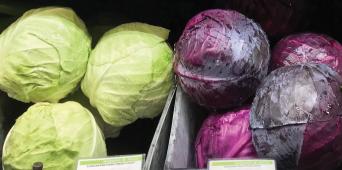
Slice It, Dice It, Serve It: Cozy Up to Cabbage
This humble yet sturdy green shone in 2020, a year that featured fewer shopping trips.
New Ideas:
Hold the mayo and switch up your ‘slaw game. After coring your cabbage, slice it thinly. In a wide bowl, heavily salt and massage it to make sure the salt is distributed. Put a plate on top of the cabbage and weigh it down with whatever you have at hand (canned beans or a small pot filled with water will work in a pinch). Allow to sit for at least 30 minutes to two hours. The salt will draw out the water, leaving you with a softened yet crunchy brassica.
Drain the drawn liquid. If you’re concerned about the salt, you can rinse your cabbage. Dress however you please — a carrot-ginger dressing works well. Mix in julienned carrot, radishes or thinly sliced peppers. Go bold with the flavors and enjoy a cabbage-forward slaw.
Roast it! Cabbage holds up well against the heat of the oven. There are a number of ways you can do it:
- Core and slice thickly into planks or wedges;
- Roast with the core still intact, or even whole. Roasting will bring out some of its natural sweetness while adding tenderness and crispy-ness. Serve plain or dress up with your favorite accompaniment for roasted Brussels sprouts. Impress your dining companions with a whole roasted cabbage sliced into wedges and dressed like a wedge salad.
Braise it! A little bit of flavorful liquid and low heat can turn cabbage into a delightful side or make it the centerpiece of a plant-based dinner. Whether chopped or cut into wedges, this sturdy vegetable can turn silky and tender. It picks up the flavors of the liquid, whether that’s a soy sauce-based braise or a more vinegar-y affair like southern collards and turnip greens.
Ferment it! From the sauerkraut of Europe to the kimchi of Korea, fermented and pickled cabbages have been staples across the globe. A simple sauerkraut starts almost exactly like the previous slaw suggestion, except that you’ll be storing the cabbage for longer and will fully submerge it in its own liquid until the lovely lactobacillus bacteria go to work. For more detailed directions, there are numerous reliable guides online and in print.

